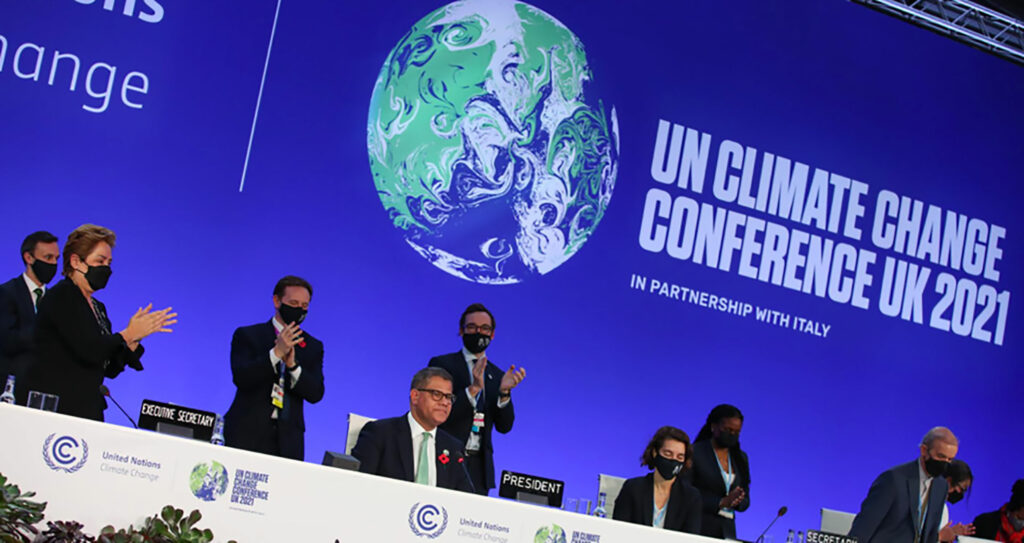

The following article is a preview of a new and ambitious project called "Green Paper" that we will unveil during the second quarter of 2021.

“This is a fragile win. We can now say that we have kept 1.5°C degrees alive. But its pulse is weak and it will only survive if we keep our promises and translate commitments into rapid action”.
Alok Sharma, president of COP26.
Is this a message of hope or deep anxiety? It’s ambiguous, at best. But what exactly was COP26, and why this shaky statement by its president?
In 1994, 197 members agreed on the United Nations Framework Convention on Climate Change (UNFCCC). Each member is a ‘party’ to the treaty, so COP stands for Conference of the Parties - COP26 was their 26th meeting.
Over the years, it’s been tricky to hammer out agreements on making the difficult changes needed to halt or reverse climate change, despite the increasing urgency in all parts of the globe. There are so many competing interests between states with their own domestic priorities and economies, and the countries and territories traditionally most affected by climate change have been those with the least power and influence over policy. But in 2015, the Paris Agreement made some progress among members, agreeing to:
Climate activists protested that these measures were nowhere near enough. After all, when the house across the road from your own is burning, do you sit down with your neighbour for a chat and decide that in half an hour the two of you will stroll across there with a cup of water to help?
Sea-level rise (SLR) will significantly alter coastal landscapes through inundation, erosion and salt-water intrusion of low-lying areas worldwide.
Considering that 10% of the world’s population inhabits areas less than 10 m above sea level the most dramatic and immediate effects of SLR will be the inundation of coastal lowland areas.
Source: Laboratori d’Enginyeria Marítima, Universitat Politècnica de Catalunya·BarcelonaTech, Spain: Impact of Relative Sea-Level Rise on Low-Lying Coastal Areas of Catalonia, NW Mediterranean, Spain. Uxía López-Dóriga, and José A. Jiménez).
But at least the Paris agreement was a move in the right direction. Then in a further positive move, in 2019, COP25 met in Madrid, and each nation agreed to cut their carbon emissions by the next meeting in Glasgow.
The world is now about 1.2C warmer than it was in the 19th Century - and the amount of carbon dioxide in the atmosphere has risen by 50%. So now here we are in 2021 at the COP26 meeting in Glasgow, delayed by one year because of Covid19. What were the hopes and the outcomes?
“New Glasgow climate pact offers some ‘breakthroughs’ but also ‘deep disappointment”
(Source: France24)
It is now known that we must halve global emissions by 2030 to keep worldwide temperatures at a level that will not provoke a wholescale catastrophe.
To best manage this, it had been hoped that there would be an agreement in Glasgow to really accelerate the rate of change with a commitment from all countries to phase out the use of fossil fuels and coal, but in the end, this was downgraded to a ‘phasing down’ of coal usage.
However, this is significant as the first-time fossil fuels have been mentioned in any COP text, even though they are responsible for 90% of the greenhouse gas emissions which cause rising temperatures.
When talking about climate-induced temperature rises, we measure against pre-industrial levels.
The previous “well-below” 2.0C levels agreed in Paris (COP 21) would have taken us to a potential 3.7C rise against those pre-industrial levels by the end of the century, catastrophic for humanity.
Now, with the decision in Glasgow for a 1.5C global temperature limit, the outcome is still uncertain, but there is a better, if small, chance of keeping the world safe.
With temperature levels now truly front and centre of attention, a second positive to come out of COP26 is the decision to speed up national efforts to reduce emissions and contribute to climate solutions, with the next check-in at the end of 2022.
Unlike the previous five-year intervals, more frequent accounting among the nations will tighten scrutiny and commitment to action.
On top of these crucial decisions around emissions, the power of nature was recognised in its ability to combat the climate crisis. $20bn from private and public sources was committed to forest protection, and more than 100 countries pledged to reverse deforestation by 2030 at the latest. On the other hand, one of the greatest disappointments of COP26 was felt by the most vulnerable nations, who encountered a deep lack of financial support for their experience of rapid loss of homes and livelihoods, and damage to land and infrastructure.
As Barbados’s Prime Minister Mia Amor Mottley said in her address to the delegates, for her country, a 2-degree Celsius rise in global temperature would be a “death sentence.” Outside the Glasgow venues and via media around the world, climate activists demonstrated and spoke vociferously against what they saw as a lack of meaningful action, while certain commentators found some areas of very cautious optimism.
So, the jury is out while the clock ticks on.
Can the COP countries take their commitments seriously, pay the sums promised, and take action through law and influence to make severe and rapid changes to cut emissions?
Or will they shake off the dust of COP26 with a sigh of relief that it is over for another year, avert their eyes, and make music to another tune while the planet burns?
Meanwhile, the only thing sure is that next year, in November 2022, Egypt will host the next COP session, the 27th,to build on previous successes and pave the way for future ambition to address climate change effectively.
Copyright HOMA 2022- Issued by Homa Marketing dept. on February 2022
For further information, please contact: info@homaeurope.eu
